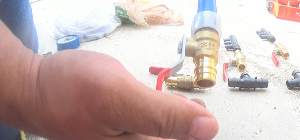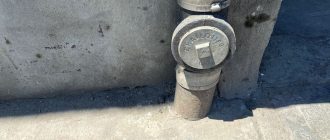Efficient Hot Water Recirculation Systems: Saving Time and Money
Hot water recirculation system design is an essential consideration for any commercial or residential building. Without a properly designed system, users may experience long wait times for hot water, wasted water and energy, and reduced overall satisfaction. A well-designed system ensures that hot water is readily available at all fixtures, minimizing both water and energy waste.
One of the key components of a hot water recirculation system is a hot water heater circulating pump. This pump works to continuously circulate hot water throughout the system, keeping it readily available at all times. By eliminating the need to wait for hot water to reach the faucet or shower, users can enjoy instant access to hot water, improving their overall experience and satisfaction.
Furthermore, a hot water recirculation system can result in significant energy savings. By keeping hot water readily available, it reduces the need for re-heating and minimizes the amount of energy wasted. This can lead to lower utility bills and a reduced environmental footprint.
In conclusion, a well-designed hot water recirculation system, including a hot water heater circulating pump, offers numerous benefits, including instant access to hot water, minimized water and energy waste, and potential cost savings. To ensure maximum efficiency and effectiveness, it is important to follow best practices and seek professional guidance when installing or upgrading a hot water recirculation system.
Overview
Hot water recirculation systems are designed to provide instant hot water to a faucet or a shower without the need to wait for the cold water to be drained. This system ensures that you have hot water on demand, saving you time and water.
The design of a hot water recirculation system includes a pump that circulates hot water through a loop of pipes from the water heater to the fixtures in your home. The pump is usually installed near the water heater and is activated by a switch or a timer. When the pump is activated, it pushes the hot water through the pipes, bringing it to the fixtures quickly and efficiently.
There are several benefits to having a hot water recirculation system. Firstly, it eliminates the need to wait for hot water, which can save you valuable time, especially in the morning when you are rushing to get ready for work. Secondly, it helps to conserve water, as you no longer need to let the cold water run while waiting for the hot water. This can lead to significant water savings over time.
Additionally, a hot water recirculation system can help to save energy. When hot water is constantly circulating through the pipes, it reduces the amount of heat lost as the water sits in the pipes. This means that your water heater doesn’t have to work as hard to keep the water hot, resulting in energy savings and lower utility bills.
In conclusion, a hot water recirculation system is a great investment for any home. It provides instant hot water, saves water, and can even help to reduce energy consumption. Consider installing a hot water recirculation system in your home to enjoy these benefits.
Problem Statement
When it comes to hot water systems, many homeowners face the common problem of waiting for hot water to reach their faucets and showers. This issue occurs because the hot water must be transported from the water heater to the desired outlet, which can take some time.
To address this problem, hot water recirculation systems have been developed. These systems use a hot water pump to continuously circulate hot water through the pipes, ensuring that hot water is instantly available at each faucet or shower. However, not all hot water recirculation system designs are equal in terms of performance and efficiency.
Choosing the right hot water recirculation system design is crucial to ensure optimal performance and minimize energy consumption. A poorly designed system might lead to excessive energy usage or insufficient hot water supply, defeating the purpose of installing such a system.
| Inefficient System Design | Energy Consumption | Insufficient Hot Water Supply |
| A poorly designed hot water recirculation system may result in inefficient water flow and heat loss, leading to increased energy consumption. | The continuous operation of the hot water pump in an inefficient system can significantly increase energy usage, resulting in higher utility bills. | A poorly designed system may fail to provide a sufficient supply of hot water to all outlets, leaving some faucets and showers with lukewarm or cold water. |
Therefore, it is essential to understand the different factors that contribute to the efficient operation of a hot water recirculation system. By considering these factors and implementing best practices, homeowners can ensure that they have a hot water system that meets their needs while minimizing energy consumption and maximizing efficiency.
Benefits
A hot water recirculation system offers numerous benefits for both homeowners and businesses. Here are some of the key advantages:
- Energy Savings: With a hot water recirculation system, you can save energy by reducing the amount of water wasted while waiting for it to get hot. The system eliminates the need to let the water run until it reaches the desired temperature, resulting in lower energy bills.
- Convenience: A hot water recirculation system provides instant hot water at any faucet or fixture in your home or business. Say goodbye to cold showers and wait times for hot water, as the system ensures that hot water is always readily available.
- Water Conservation: By recirculating hot water instead of letting it go down the drain, a recirculation system helps conserve water. This is especially beneficial in areas where water scarcity is a concern, as it reduces overall water consumption.
- Comfort: Enjoy the luxury of instant hot water throughout your home or business. Whether you need hot water for showers, washing dishes, or doing laundry, a hot water recirculation system ensures consistent and comfortable temperatures.
- Reduced Plumbing Expenses: Constantly running hot water pumps can help prevent the occurrence of frozen pipes, which can be costly to repair. In colder climates, a recirculation system can prevent pipes from freezing during winter months.
- Increased Lifespan of Water Heaters: By reducing the workload of your water heater, a hot water recirculation system can extend the lifespan of the unit. The system helps to maintain a continuous supply of hot water, preventing the water heater from working excessively.
Overall, investing in a well-designed hot water recirculation system with an efficient hot water pump can significantly enhance convenience, energy efficiency, and water conservation in your home or business.
Energy Efficiency
When it comes to hot water recirculation systems, energy efficiency is a key benefit. These systems are designed to provide instant hot water at any faucet in your home, which means you no longer have to waste water running it until it reaches the desired temperature.
One of the main components of a hot water recirculation system is a hot water pump. This pump circulates hot water through the pipes, keeping it constantly flowing and ready for use. By eliminating the need to run water to get it hot, you can save a significant amount of both water and energy.
Additionally, the design of hot water recirculation systems is focused on minimizing heat loss. The pipes are insulated to prevent heat from escaping, ensuring that the hot water stays hot until it reaches its destination. This further reduces the energy required to maintain the desired temperature, resulting in additional energy savings.
Overall, using a hot water recirculation system promotes energy efficiency by reducing water waste and minimizing heat loss. This can lead to lower energy bills and a more sustainable home. So, if you’re looking to save both water and energy, consider installing a hot water recirculation system with an efficient hot water pump and optimal system design.
Water Conservation
Using a hot water recirculation system can not only provide convenience but also help in conserving water. With a hot water heater circulating pump, you can minimize the amount of water wasted while waiting for hot water to reach the desired faucet or shower.
Traditional plumbing systems typically require the water to run for a while before it becomes hot, resulting in a significant amount of water being wasted. However, by installing a hot water pump, you can eliminate this waiting time and save potentially thousands of gallons of water each year.
Additionally, a hot water recirculation system can help reduce energy consumption. When the hot water is readily available, you no longer need to let the water run for minutes, trying to achieve the desired temperature. This means less energy is required to heat the water, resulting in lower utility bills and a reduced carbon footprint.
By opting for a hot water recirculation system, you are contributing to water conservation efforts and actively participating in sustainable living practices. It is a small change that can make a big difference, not only in terms of water and energy savings but also in preserving the planet for future generations.
Cost Savings
Hot water recirculation systems offer significant cost savings for homeowners. By installing a hot water recirculation system, you can reduce energy consumption and lower your utility bills.
One of the main sources of energy waste in a home is the hot water heater. Traditional hot water heaters constantly heat water, even when it is not being used. This means that energy is being wasted on heating water that is not needed, resulting in higher energy bills.
A hot water recirculation system, on the other hand, keeps hot water circulating through the pipes, so it is instantly available when you need it. This eliminates the need to wait for hot water to reach the faucet, which can waste gallons of water and energy.
By reducing the amount of water and energy wasted, a hot water recirculation system can result in significant cost savings. Homeowners can expect to see a reduction in their water and energy bills, as well as lower maintenance and repair costs for their hot water heater.
When designing a hot water recirculation system, it is important to consider the efficiency of the hot water heater circulating pump. A high-quality pump will ensure that hot water is circulated efficiently, minimizing energy waste and maximizing cost savings.
| – Instant hot water – Energy savings – Water savings – Lower utility bills |
– Proper pump selection – Insulated pipes – Timer or motion sensor activation – Regular maintenance |
Overall, investing in a hot water recirculation system can lead to significant cost savings for homeowners. Not only will you save money on your utility bills, but you will also reduce your carbon footprint by conserving water and energy.
Types of Hot Water Recirculation Systems
When it comes to hot water recirculation systems, there are several different types to choose from. Each type has its own advantages and is designed to meet specific needs. Here are the most common types of hot water recirculation systems:
| Traditional Recirculation Systems | These systems use a dedicated return line to circulate hot water from the hot water heater to the fixtures and back. A hot water circulating pump is installed to ensure continuous circulation, providing instant hot water at the tap. |
| Demand Controlled Recirculation Systems | These systems utilize a flow sensing device that activates the circulation pump only when there is a demand for hot water. By only circulating hot water when needed, these systems help conserve energy and reduce utility costs. |
| Thermostatic Recirculation Systems | Thermostatic recirculation systems use a thermostatic valve to control the flow of hot water. The valve senses the temperature of the water in the hot water supply line and opens or closes accordingly to maintain a consistent temperature throughout the system. |
| On-Demand Recirculation Systems | On-demand recirculation systems, also known as retrofit systems, are designed to be installed on existing plumbing systems without the need for a dedicated return line. These systems use a bypass valve or a pump that can be activated with a button or a motion sensor to circulate hot water when needed. |
When selecting a hot water recirculation system, it’s important to consider factors such as the size of your plumbing system, the distance between the hot water heater and the fixtures, and your specific hot water needs. Consulting with a professional plumber can help guide you in choosing the right system for your home.
Traditional Pump Systems
In the past, traditional hot water recirculation systems relied on a hot water heater circulating pump to provide continuous hot water throughout a building or home. These systems were designed to constantly circulate hot water from the water heater to various fixtures and appliances, ensuring that hot water was always readily available.
Traditional pump systems typically consisted of a dedicated return line that connected the hot water supply line to the water heater. The circulating pump, often located near the water heater, would continuously pump water from the heater through the return line and back into the supply line.
This continuous circulation of hot water helped to reduce the waiting time for hot water at faucets and showers, eliminating the need to let the water run until it reached the desired temperature. It also reduced water waste and improved energy efficiency by minimizing the amount of cold water that needed to be discharged while waiting for hot water.
With their simple and straightforward design, traditional pump systems were widely used and considered the standard for hot water recirculation in the past. However, they did have some limitations. For example, they required a dedicated return line, which could be challenging to install in existing buildings without major plumbing modifications.
In addition, traditional pump systems could be less efficient in terms of energy consumption compared to newer technologies. Since these systems operated continuously, they could consume more electricity or gas to maintain the circulation of hot water, even when it was not needed.
Despite these limitations, traditional pump systems have been used successfully in many residential and commercial applications over the years. They continue to provide a reliable and consistent supply of hot water, especially in buildings where retrofitting or upgrading to newer technologies may not be feasible or cost-effective.
Overall, traditional pump systems have played a valuable role in hot water recirculation and have paved the way for advancements in system designs and technologies.
Demand Control Systems
Hot water demand control systems are advanced additions to hot water recirculation system design that help optimize energy usage and reduce waste. These systems are designed to regulate hot water circulation based on the actual demand from users, thereby saving energy and improving overall system efficiency.
The main component of a demand control system is a hot water pump, which is responsible for circulating hot water through the pipes of the recirculation system. However, unlike traditional recirculation systems where the pump runs continuously, demand control systems utilize advanced sensors and controllers to ensure that the pump operates only when there is a demand for hot water.
By using advanced sensors, demand control systems are able to detect when hot water is needed and activate the pump accordingly. This ensures that hot water is readily available to users at the desired temperature, while minimizing the energy consumption associated with continuous pump operation.
One of the key benefits of demand control systems is the significant reduction in energy waste. By operating the hot water pump only when needed, these systems help conserve energy, resulting in lower utility bills and a reduced carbon footprint. Additionally, the optimized energy usage provided by demand control systems can also lead to extended longevity of the hot water recirculation system.
Furthermore, demand control systems improve overall comfort and convenience for users. With these systems in place, there is a minimized wait time for hot water, as it is readily available upon request. This eliminates the need for users to run the tap for extended periods of time, wasting both water and energy.
In conclusion, demand control systems are an excellent addition to hot water recirculation systems, providing energy savings, improved efficiency, and enhanced user convenience. By regulating hot water circulation based on demand, these systems optimize energy usage and reduce waste, resulting in both economical and environmental benefits.
Best Practices for Installation
1. Properly Size the Hot Water Recirculation System Design
Before installing a hot water recirculation system, it is important to properly size it to ensure optimal performance. Consider factors such as the size of the house, the distance between the furthest faucet and the hot water heater, and the number of fixtures that will be connected to the system. A hot water circulation pump should be selected that can handle the required flow rate and pressure.
2. Install a Dedicated Line for the Return Loop
For the best performance, it is recommended to install a dedicated line for the return loop of the hot water recirculation system. This means running a separate pipe from the furthest fixture back to the hot water heater. This helps to minimize heat loss and ensures that hot water is readily available at all faucets.
3. Insulate the Hot Water Pipes
To further reduce heat loss and improve the efficiency of the hot water recirculation system, it is advisable to insulate the hot water pipes. This helps to keep the water hotter for longer periods, reducing the need for the circulating pump to constantly run. Insulating the pipes also helps to mitigate any potential condensation issues.
4. Use a Timer or Sensor for Pump Activation
A hot water recirculation system can be set up to be activated by a timer or a sensor. This allows the homeowner to customize the system according to their specific needs and usage patterns. A timer can be set to activate the pump during peak usage hours, while a sensor can be used to activate the pump only when hot water is required.
5. Regularly Maintain and Service the Circulating Pump
To ensure the longevity and optimal performance of the hot water recirculation system, it is important to regularly maintain and service the circulating pump. This includes checking for any leaks, ensuring proper lubrication, and cleaning or replacing the pump if necessary. Regular maintenance will help to prevent any potential issues and prolong the lifespan of the system.
By following these best practices for installation, homeowners can maximize the benefits of hot water recirculation systems and enjoy the convenience of instant hot water at any faucet in their home.
Location of Pump
The hot water pump, also known as the hot water heater circulating pump, is an essential component of a hot water recirculation system. It is responsible for moving hot water from the water heater to the various fixtures and appliances in your home, ensuring that hot water is readily available whenever you need it.
When it comes to the location of the pump, there are a few important factors to consider. First and foremost, the pump should be installed as close to the water heater as possible. This is because the main purpose of the pump is to circulate hot water between the water heater and the fixtures, and having the pump located near the water heater helps to minimize heat loss in the pipes.
In addition to being close to the water heater, the pump should also be installed in a convenient and accessible location. This is important for maintenance and troubleshooting purposes. If the pump is hidden away in a difficult-to-reach area, it can be challenging to perform regular maintenance tasks or fix any issues that may arise.
Another consideration when determining the location of the pump is noise. While modern hot water pumps are designed to operate quietly, they can still produce some noise, especially if they are installed in a confined space. To minimize noise disruption, it is recommended to install the pump in a well-ventilated area or consider using noise-reducing insulation materials.
Lastly, it is crucial to ensure that the pump is placed in a suitable position for proper water flow. The pump should be installed on the return line of the hot water system, which is the line that carries the cooled-down water back to the water heater for reheating. Installing the pump on the wrong line can lead to poor circulation and reduced efficiency of the hot water recirculation system.
In conclusion, the location of the hot water pump is a critical consideration for an effective hot water recirculation system. It should be installed near the water heater, in a convenient and accessible location, while also taking into account noise reduction and proper water flow. By selecting the optimal location for the pump, you can ensure efficient and reliable hot water circulation throughout your home.
Question-answer:
What is a hot water recirculation system?
A hot water recirculation system is a plumbing system that continuously circulates hot water throughout a building, ensuring that hot water is instantly available at any fixture or appliance.
What are the benefits of a hot water recirculation system?
There are several benefits of a hot water recirculation system. Firstly, it provides instant hot water, eliminating the need to wait for the water to heat up. Secondly, it conserves water by reducing the amount of water wasted while waiting for hot water. Additionally, it can save energy and reduce utility bills by minimizing the time it takes for hot water to reach fixtures or appliances.
How does a hot water recirculation system work?
A hot water recirculation system works by using a pump to continuously circulate hot water through the pipes of a building. A bypass valve is used to control the flow of hot water, ensuring that it is only circulated when needed. The system can be installed with either a dedicated return line or by using the cold water line as the return line.
What are some best practices for installing a hot water recirculation system?
When installing a hot water recirculation system, it is important to consider a few best practices. Firstly, proper pipe insulation should be used to minimize heat loss and ensure efficient operation. Secondly, a timer or sensor can be installed to control when the system is active, reducing energy consumption. Finally, regular maintenance should be performed, including flushing the system to remove any sediment or debris.





